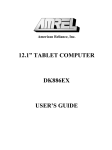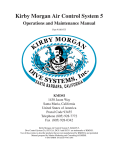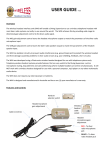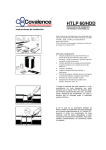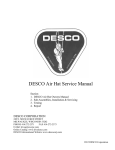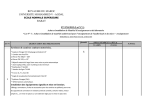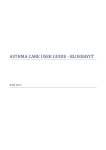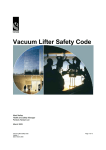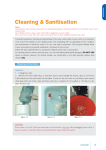Download IMCA Safety Flash 04/03
Transcript
AB IMCA Safety Flash 04/03 May 2003 These flashes summarise key safety matters and incidents, allowing wider dissemination of lessons learned from them. The information below has been provided in good faith by members and should be reviewed individually by recipients, who will determine its relevance to their own operations. The effectiveness of the IMCA safety flash system depends on receiving reports from members in order to pass on information and avoid repeat incidents. Please consider adding the IMCA secretariat ([email protected]) to your internal distribution list for safety alerts and/or manually submitting information on specific incidents you consider may be relevant. All information will be anonymised or sanitised, as appropriate. A number of other organisations issue safety flashes and similar documents which may be of interest to IMCA members. Where these are particularly relevant, these may be summarised or highlighted here. Links to known relevant websites are provided at www.imca-int.com/links Additional links should be submitted to [email protected] 1 1.1 Diving Fatality Incident Overview A member has reported the following diving fatality during a surface supplied diving operation being undertaken from a platform while two divers were working in close proximity to each other. Communication to the surface was maintained through an audio link with both divers and helmet mounted video systems, however this only allowed the supervisor to view one diver at a time through a single monitor. The first diver had been in the water for around 50 minutes when the second diver descended to the worksite working at a depth of 48ft (14.5m). Approximately 48 minutes later the supervisor lost communication with the second diver and asked the first diver to investigate. The first diver sighted the second diver; his helmet was missing and he was in severe difficulties. The helmet, only a few feet away from the second diver, was still connected to his umbilical with the helmet free flow fully open. His umbilical was snagged in an obstruction on the platform. The first diver tried to provide air to the second diver though his pneumo hose and, when the surface standby diver reached the site, both he and the first diver unsuccessfully attempted to refit the second diver’s helmet. The second diver was then released from his harness and brought back to the surface via the dive basket for emergency cardio pulmonary resuscitation (CPR) treatment. Unfortunately after 60 minutes CPR from the paramedic on the surface, the injured diver was pronounced dead by a doctor. The initial investigation identified the following: 1.2 The Diver’s Helmet The video from the first diver’s camera showed that the second diver’s helmet rear fastening mechanism was not properly secured while he was under water 16 minutes prior to the incident. There was no evidence as to whether the helmet’s back securing assembly had been properly fastened on dressing or had become unfastened during the dive. The company involved has initiated an immediate inspection of all their helmets to ensure they comply with the manufacturer’s service manual. NB We are aware that a number of IMCA diving contractor members have modified this particular type of helmet (Kirby Morgan (KMDSI) Superlite 17B) which they feel may provide an extra level of safety and to prevent the helmet becoming detached from the diver even in the event of the helmet and neck clamp assembly becoming separated. We are also aware that some diving contractors have included the addition of a flat washer between the end of the alignment sleeve and the alignment screw. Kirby Morgan Dive Systems Inc. has issued the following statement in this regard: “KMDSI has never seen a need to put restraining bands or rubber bands on the SL-17 helmets. As we mentioned before if regularly scheduled inspections, maintenance and proper dressing procedures are being accomplished and supervisors check their divers the helmet will not come off accidentally. We know that some have installed them but we have always worried that by using them tenders and supervisors may become complacent in their dressing and pre dive procedures. The fact is the helmet should never come off in the water by accident. KMDSI has no authority to stop people from modifying their equipment. All we can do is make suggestions. The same holds true with users that want to use aftermarket parts such as headliners, oral nasal masks and neck-dams. The use of such Safety Flash aftermarket items voids warranties and releases KMDSI of any liabilities. The ultimate decision is up to the owner of the helmet or individual company policies. However, anytime the end user makes modifications or uses nonKMDSI components, they must exercise extreme caution to insure these components do not alter or affect the safety of the helmet. Care must be taken when drilling through the helmet shell and proper sealing must be done to avoid water entry. The use of restraints can also pose an entanglement problem. KMDSI will always try to work with the end user and industry as a whole to ensure their needs are met.” A copy of a modification installation instruction, used by some diving contractors and available from one of the main equipment suppliers, is attached for information at Appendix 1. 1.3 Emergency Response The emergency response systems were not ready to respond to the sudden emergency. The standby diver was not immediately sent by the supervisor to help and the dive basket was at the surface. It took eight minutes from the time when the supervisor lost communications with the injured diver until he was recovered to the surface. The company involved is to review its emergency response and preparedness plans for all foreseeable emergencies and to instigate regular exercises. Guidance note IMCA D 023 (Diving Equipment Systems Inspection Guidance Note (DESIGN) for Surface Orientated Systems (Air)) specifies that each dive basket be provided with one or more emergency air cylinders and a facility to provide the diver with a SCUBA mouthpiece and a valved flexible hose connection to provide an air supply for the diver in an emergency. For this facility to be of use to a diver in distress, the dive basket needs to be deployed in the water in the vicinity of the working diver(s). 1.4 Monitors There was no second monitor in dive control to allow the supervisor to view both divers’ pictures at the same time and thereby be able to initiate prompt response/ action. The company involved is ensuring that all dive control rooms will have a functioning, individual monitor for each working diver. Installation Instructions Divex Superlite 17B Jocking Harness Assy. Part # DD011101 The jocking harness assy comprises 2 main components a) the jocking strap & tensioning buckle / left & right shoulder wire harness b) the safety side strop assy’s which are attached to the helmet 1) installation of the side strops to the helmet: The side strop assy’s are bolted through the helmet shell on the flat surface of the earphone “pockets” area. Retained by washer and nyloc nut set per bolt. The helmet requires to be drilled each side , to permit the 2 retaining bolts which retain the eye plate/strop assy to be fitted. The eye plate should be positioned as low as possible but ensuring all the mounting surface of the plate lies upon the external flat surface of the shell ( see figure1 ) Figure 1 H:\My Documents\Installation instructions.doc Page 1 of 3 To install : Remove the helmet liner and the earphones from their retaining clips. In order to prevent the ingress of dust from the drilling of the shell, take suitable precautions to prevent ingress to the regulator/oral nasal/valves etc. Best of all strip the shell of all breathing circuit components and face port before drilling and then clean thoroughly before re-assembly. Position the mounting plate as described and mark the position of the 2 holes to be drilled. Using a 4.5mm drill and working from outside slowly drill the 2 holes Do not use excess force when drilling and clean out hole often prior to breaking though to the inside, this helps reduce the amount of fibreglass dust getting inside the helmet shell. Clean /deburr around inside face of holes so that the nut/washers will sit as neatly as possible on the inside face of helmet shell. Take the strop plate assy and test fit using the fixture bolts/washers/nuts provided. Helmet shells vary slightly in their thickness and it may be necessary to file down the bolt to attain a neat length ie without excessive protrusion through retaining washer & nut set. When satisfied lengths are correct and ensuring all surfaces are CLEAN & dry, apply a light coating Dow Corning 1200 primer then of RTV 732 Silicone sealant to the helmet outer gel coat on the area of the plate position and to the back face of plate. Position plate and assemble bolts/washers/nuts and tighten nuts to a snug but not excessive fit. ( max torque 15 inch pounds) Use of the assy: Position jocking strap assy between legs with wires running over each shoulder and with adjustment buckle to the front with the adjustment webbing tail facing forwards (i.e. away from Diver’s body). Loosely adjust to take up most slack. Don the helmet Yoke / Neckdam assy as normal. Fit helmet to neck clamp assy. as per manufacturers instructions and check in accordance with Dive company pre dive checklist( if applicable) Once OK & checked, engage the wire strop which passes over each shoulder into its helmet side strop “carbine” hook and then adjust jocking strap for comfort and security.( see figure 2) H:\My Documents\Installation instructions.doc Page 2 of 3 figure 2 showing front & rear view with shoulder wires located in helmet side strop assy hooks and jock strap adjusted to be comfortable. H:\My Documents\Installation instructions.doc Page 3 of 3







